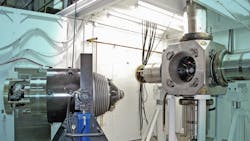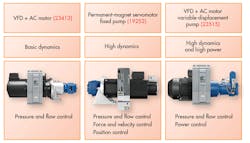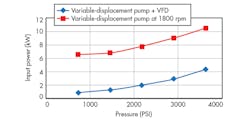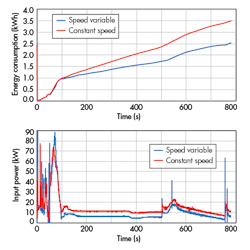A Variable-Speed Revolution in Hydraulics
This file type includes high resolution graphics and schematics when applicable.
Faster, cheaper, quieter, more precise, more robust, and last but not least, more energy-efficient—this is the typical wish list a customer would bestow on its machine builder. It’s not hard to imagine that design engineers often wrack their brains to fulfill all of these often contradictory requirements.
In recent years, though, tremendous progress has been made in machine design and control methods to help meet these demands. One of the main changes is the migration of drive technology from fluid-power to “full-electric” solutions. As a result, electromechanical actuators, featuring high efficiency, ease of integration, and high precision, are now replacing traditional hydraulics. An added bonus is the absence of hydraulic fluid and the associated maintenance.
Nevertheless, electrohydraulic drives are still indispensable when the need arises for large forces and high torques. The well-known advantages of fluid power include: high power density, robustness, and simple realization of fast linear movements under load. These features help hydraulics win the battle against electromechanical servodrives. This is especially true in key market segments such as plastic machinery, stamping and forming presses, metallurgy, testing machinery, and other “heavy-duty applications.”
The current “electrification” trend in industrial machinery has also influenced the landscape of fluid power, with variable frequency drives (VFDs) and servodrives replacing traditional fixed-speed ac motors. The combination of advanced electric drive technology coupled with hydraulics opens a new chapter in electrohydraulic-drive systems.
Machine builders can now maintain characteristics of “traditional hydraulics,” robustness and power density, while acquiring advantages of electric drives: drive “intelligence” and ease of integration with factory automation systems. Additionally, adjusting the pump speed to flow demands provides an increase in energy efficiency and dramatically reduces the audible noise and sound pressure level, especially during part-load operations when less than maximum pump flow is required.
Look for System Inefficiencies
When analyzing the energy efficiency of the overall system, it’s important to review the machine’s duty cycle and its hydraulic and electric operating points (Fig. 1). Furthermore, the relationship between hydraulic and electric process variables should be carefully evaluated, particularly pump pressure and flow (motor speed) that correlate to the drive’s motor torque (resulting from drive current). Electrical engineers typically understand machine load as the motor torque and machine speed as drive speed, while fluid-power engineers operate in pressure and flow units. The difference in how we define the machine motion using motor torque and speed, as compared to pump pressure and flow, should be understood.
Often these different terms lead to communication issues between electrical and fluid-power specialists who are sizing the system and its components. Luckily, the hydraulic and electric values can be easily correlated using a few simple formulas.
The relationship between pump pressure and motor loading torque is expressed as:
ML = (VP × Δp)/(24 × π × ηmech )(lb-ft)
and the pump speed is defined as:
n = (Q × 231)/(VP ×_ηvol )(rpm)
where Δp = pressure differential in psi; VP = pump displacement per revolution in in.3; Q = pump flow in gpm; and ηmech, ηvol = pump mechanical and volumetric efficiency.
The resulting power that needs to be delivered to the pump is therefore calculated as:
P = (n × ML)/(5252 × ηP ) = (âp × VP)/(1714 ×ηP )(HP)
with an overall pump efficiency of ηP = ηmech × ηvol.
When calculating the electrical input power for a motor-pump group, the efficiency of the motor (ηmot) should be considered:
ηT = ηP × ηmot
While the calculations appear to be straightforward, in reality, calculating the overall efficiency of a motor-pump group can be a tedious task. That’s because most power losses are the result of many variables.
Efficiency of a variable-displacement pump is primarily a function of three variables: pump pressure, speed, and displacement (pump stroke). Generally, the variable-displacement pump’s efficiency is higher when the pump operates at a greater displacement. The losses in a pump are divided into volumetric and mechanical losses. Volumetric losses are a function of the pump’s internal leakage; the dissipated power is a product of leakage flow (QL) and the pump’s differential pressure: PL = Δp × QL. Pump mechanical losses are the product of frictional torque and drive speed: PFr = n × MFr.
The electrical losses for the drive motor are divided between copper losses and iron losses. The iron losses are approximately proportional to the motor’s drive frequency, and therefore its speed, PFe ~ n, which also correlates to pump flow. Copper losses in the drive motor result from resistance in the windings, and are proportional to the square of the motor current: PCu ~ I2. Current is proportional to torque.
When a VFD is used to drive the motor, current losses in the VFD electronics are typically proportional to motor current: PI ~ I. Motor current is a function of motor torque, I ~ ML, which is directly related to pump pressure and displacement. Thus, the electric losses depend directly on the hydraulic operating point.
Analysis of the above relations between hydraulic flow and pressure, hydraulic output power, system power losses, and the resulting input electric power, shows that power consumption of a hydraulic power unit can be reduced by:
• Using higher efficiency components, such as premium efficiency ac motors or permanent-magnet servos rather than standard ac motors, and pumps with higher volumetric efficiency. Also, it’s important to keep components well maintained.
• Sizing and utilizing the system so that the working points for most of the operating cycle are at the highest efficiency point for the hydraulic pump and electric motor. This can be achieved by adjusting the pump’s displacement and pump speed to match the flow requirements while keeping load on the drive at a “sweet spot of efficiency.”
• Reducing hydraulic throttling losses by operating the pump at lower pressure, which can lower the overall power requirement. This, however, may reduce controllability of the hydraulics in some systems. Eliminate the use of proportional valves and other traditional throttling control methods by using more efficient volumetric control, where flow is controlled by changing the pump drive speed and/or adjusting the displacement of the pump. All pressure-reducing and flow-throttling valves are resistive components that lower overall efficiency. By reducing throttling losses, it shrinks the amount of heat transferred to the oil. Reduced heating allows for smaller cooling system capacity and lowers the parasitic power needed to maintain optimum oil temperature.
A properly designed variable-speed pump system can satisfy all of above points.
System Considerations
Optimal utilization of variable-speed pump drives requires that design engineers understand the unique features of VFDs, hydraulic systems, and the properties of the process being driven. In many cases, further elimination of throttling losses may need a review of the system design, as well as modifications to a hydraulic system design.
The goal is to have a system that meets the dynamic requirements and accuracy, but also focuses on overall energy efficiency. When applying a VFD/induction motor or a permanent magnet servomotor (PMM) as a pump drive, the dynamic behavior will differ from a traditional system using a constant-speed pump drive and throttling control valves.
A number of different design solutions can be applied to systems using variable-speed pump drives. Selecting the best (or correct) design depends on a number of factors. Dynamic performance and power requirements can determine the choice of motor type (Fig. 2). For applications that require the fastest response times and high accuracy, a PMM is often the best solution. In fact, this technology is used extensively today in plastic injection-molding machines. These drive systems offer extremely high performance and high productivity rates.
Due to their high power density and low mechanical inertia, PMMs also feature the highest acceleration capabilities. The high dynamics allow for complex machine control tasks, such as force, speed, and cylinder position control, to be realized without using hydraulic proportional valves. The main limitation of PMM drives involves the maximum continuous output power, typically less than 60 kW. Power units that need more than 60 kW may require multiple PMM pump units.
Standard asynchronous induction motors driven with VFDs can be used in higher-power applications that don’t require direct control of high dynamic axes. Using standard motors with VFDs, operating in a sensorless vector control mode (no separate motor feedback device required), can offer a cost-effective solution. However, the system designer should be aware of the limitations when using these drives.
System response times are longer due to the high mechanical inertia of the induction motor. Variable-speed pump drives, using standard induction motors and VFDs, are widely used in woodworking, press forming and stamping presses, plastics machinery, heavy industry, and machine tool cutting applications in which the control requirements typically regulate system pressure or flow.
When selecting a pump for variable-speed operation, several additional factors beyond pressure and power must be considered. It’s essential to review unique requirements that aren’t usually involved with conventional designs, such as drive speed and acceleration rates of the pump’s rotating elements, .
Internal gear or piston pumps are commonly used with variable-speed drives. Internal gear pumps are characterized by high efficiency, low flow ripple, low mechanical inertia, and high-pressure capability. These features often make them the pump of choice when driven by PMMs on injection-molding machines. Limitations of internal gear pumps include a fixed displacement and the requirement of a minimum drive speed when supplying low flow at high pressure.
Axial piston pumps, either fixed or variable displacement, have the advantage of high efficiency at low drive speeds, making them ideal for pressure holding over long operating cycles. Using a variable-displacement piston pump makes it possible to adjust pressure, the pump displacement, and motor speed (torque and speed) to optimal working points, thereby minimizing electric, hydraulic, and mechanical losses. In addition, VFD current and motor copper losses can be reduced via drive speed and displacement adjustments.
Figure 3 presents energy consumption of a variable-displacement pump during pressure holding when operating in both variable- and constant-speed modes. The measurement shows that the energy consumption during variable-speed operation is affected mainly by pressure-dependent volumetric losses in the pump, while increasing the pressure had little effect on the current-related losses in the VFD and motor.
A high-response variable-displacement pump that utilizes closed-loop displacement control, such as Rexroth’s DFEn, can compensate for the relatively low dynamics of a VFD/induction motor drive. Since the pump displacement control can respond a magnitude faster than the motor-drive speed control, it’s possible to achieve high-control dynamics. This becomes a significant advantage when used in high-horsepower hydraulic drives.
Variable-Speed Pump for 4,000-Ton Production Press
A “smart VFD-controlled pump” was applied on a hydraulic power unit for a 4,000-ton, solid-frame super-materials press, designed by Novatek Inc., Provo, Utah (Fig. 4). Novatek plays a leading role in the field of high-pressure, high-temperature materials engineering. The press features a cubic base with six cylindrical cartridges, each tipped with tungsten-carbide tooling. A work piece, which is a cell containing raw material, is placed in the center of the press.
Inside the press, raw materials are subject to extreme pressure and temperature, similar to those found deep within the earth. Chemical and mechanical transformations of the raw material require a certain time before completion of the process. This production process can take several minutes or up to hours, depending on the materials to be processed and size of the work piece.
Hydraulic presses that have long cure or forming times can benefit by using variable-speed pump drives. This is especially true when they require high forces but little movement (flow). During pressure holding, adjusting the pump’s speed and displacement results in significant energy savings as well greatly reduced system acoustic noise. In press applications, measured noise reductions between 10 to 15 dBA were realized as a result of variable-speed pump drives.
Novatek’s solid-frame press is powered by a 125-cc Rexroth DFEn variable-displacement pump, driven by a 100-HP VFD controlled ac motor. Bosch Rexroth and Womack Machine Supply teamed together to specify the right components for the application. Womack’s long-standing relationship with Novatek and working knowledge of the application was critical to implementing this technology.
Figure 5 shows the energy comparison of the hydraulic drive during an 800-second press cycle, with the pump operating in both variable- and constant-speed modes. Lowering the speed during long pressure holding considerably lowers the energy demand.
Andrew Binversie is manager, press applications, and Paul Stavrou, manager, system applications, Bosch Rexroth Corp.
About the Author

Leaders relevant to this article:






